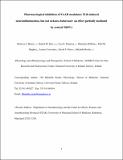| dc.contributor.author | Henry, Rebecca J. | |
| dc.contributor.author | Kerr, Daniel M. | |
| dc.contributor.author | Flannery, Lisa E. | |
| dc.contributor.author | Killilea, Marykate | |
| dc.contributor.author | Hughes, Edel M. | |
| dc.contributor.author | Corcoran, Louise | |
| dc.contributor.author | Finn, David P. | |
| dc.contributor.author | Roche, Michelle | |
| dc.date.accessioned | 2020-01-13T11:12:04Z | |
| dc.date.available | 2020-01-13T11:12:04Z | |
| dc.date.issued | 2017-02-22 | |
| dc.identifier.citation | Henry, Rebecca J., Kerr, Daniel M., Flannery, Lisa E., Killilea, Marykate, Hughes, Edel M., Corcoran, Louise, Finn, David P., Roche, Michelle. (2017). Pharmacological inhibition of FAAH modulates TLR-induced neuroinflammation, but not sickness behaviour: An effect partially mediated by central TRPV1. Brain, Behavior, and Immunity, 62, 318-331. doi: https://doi.org/10.1016/j.bbi.2017.02.016 | en_IE |
| dc.identifier.issn | 1090-2139 | |
| dc.identifier.uri | http://hdl.handle.net/10379/15695 | |
| dc.description.abstract | Aberrant activation of toll-like receptors (TLRs), key components of the innate immune system, has been proposed to underlie and exacerbate a range of central nervous system disorders. Increasing evidence supports a role for the endocannabinoid system in modulating inflammatory responses including those mediated by TLRs, and thus this system may provide an important treatment target for neuroinflammatory disorders. However, the effect of modulating endocannabinoid tone on TLR-induced neuroinflammation in vivo and associated behavioural changes is largely unknown. The present study examined the effect of inhibiting fatty acid amide hydrolyase (FAAH), the primary enzyme responsible for the metabolism of anandamide (AEA), in vivo on TLR4-induced neuroimmune and behavioural responses, and evaluated sites and mechanisms of action. Systemic administration of the FAAH inhibitor PF3845 increased levels of AEA, and related FAAH substrates N-oleoylethanolamide (OEA) and N-palmitoylethanolamide (PEA), in the frontal cortex and hippocampus of rats, an effect associated with an attenuation in the expression of pro-and anti-inflammatory cytokines and mediators measured 2hrs following systemic administration of the TLR4 agonist, lipopolysaccharide (LPS). These effects were mimicked by central i. c.v. administration of PF3845, but not systemic administration of the peripherally -restricted FAAH inhibitor URB937. Central antagonism of TRPV1 significantly attenuated the PF3845-induced decrease in IL-6 expression, effects not observed following antagonism of CB1, CB2, PPAR alpha, PPAR gamma or GPR55. LPS-induced a robust sickness -like behavioural response and increased the expression of markers of glial activity and pro-inflammatory cytokines over 24hrs. Systemic administration of PF3845 modulated the TLR4-induced expression of neuroimmune mediators and anhedonia without altering acute sickness behaviour. Overall, these findings support an important role for FAAH substrates directly within the brain in the regulation of TLR4-associated neuroinflammation and highlight a role for TRPV1 in partially mediating these effects.(C) 2017 Elsevier Inc. All rights reserved. | en_IE |
| dc.description.sponsorship | The authors would like to gratefully acknowledge funding received from the Science Foundation Ireland Research Frontiers Programme (Grant no. 11/RFP/NES/3175), The Research Office and College of medicine, Nursing and Health Sciences National University of Ireland Galway. The authors would also like to thank Patricia Calcagno for technical assistance during this study. | en_IE |
| dc.format | application/pdf | en_IE |
| dc.language.iso | en | en_IE |
| dc.publisher | Elsevier | en_IE |
| dc.relation.ispartof | Brain Behavior And Immunity | en |
| dc.rights | Attribution-NonCommercial-NoDerivs 3.0 Ireland | |
| dc.rights.uri | https://creativecommons.org/licenses/by-nc-nd/3.0/ie/ | |
| dc.subject | Toll-like receptors | en_IE |
| dc.subject | Anandamide | en_IE |
| dc.subject | Cytokines | en_IE |
| dc.subject | Neuroinflammation | en_IE |
| dc.subject | Sickness | en_IE |
| dc.subject | Anhedonia | en_IE |
| dc.subject | FEAR-CONDITIONED ANALGESIA | en_IE |
| dc.subject | INNATE IMMUNE-RESPONSE | en_IE |
| dc.subject | ENDOCANNABINOID SYSTEM | en_IE |
| dc.subject | RAT MODEL | en_IE |
| dc.subject | TNF-ALPHA | en_IE |
| dc.subject | CB2 RECEPTORS | en_IE |
| dc.subject | NITRIC-OXIDE | en_IE |
| dc.subject | ANANDAMIDE | en_IE |
| dc.subject | PAIN | en_IE |
| dc.subject | INFLAMMATION | en_IE |
| dc.title | Pharmacological inhibition of FAAH modulates TLR-induced neuroinflammation, but not sickness behaviour: An effect partially mediated by central TRPV1 | en_IE |
| dc.type | Article | en_IE |
| dc.date.updated | 2020-01-10T10:30:42Z | |
| dc.identifier.doi | 10.1016/j.bbi.2017.02.016 | |
| dc.local.publishedsource | https://doi.org/10.1016/j.bbi.2017.02.016 | en_IE |
| dc.description.peer-reviewed | peer-reviewed | |
| dc.contributor.funder | Science Foundation Ireland | en_IE |
| dc.contributor.funder | Research Office, National University of Ireland Galway | en_IE |
| dc.contributor.funder | College of Medicine, Nursing and Health Sciences, National University of Ireland Galway | en_IE |
| dc.internal.rssid | 12518191 | |
| dc.local.contact | Michelle Roche, Physiology, Rm2002 Human Biology Building, National University Of Ireland G, University Road. 5427 Email: michelle.roche@nuigalway.ie | |
| dc.local.copyrightchecked | Yes | |
| dc.local.version | ACCEPTED | |
| dcterms.project | info:eu-repo/grantAgreement/SFI/SFI Research Frontiers Programme (RFP)/11/RFP.1/NES/3175/IE/Endocannabinoid regulation of neuroinflammatory responses following bacterial and viral infection/ | en_IE |
| nui.item.downloads | 455 | |


